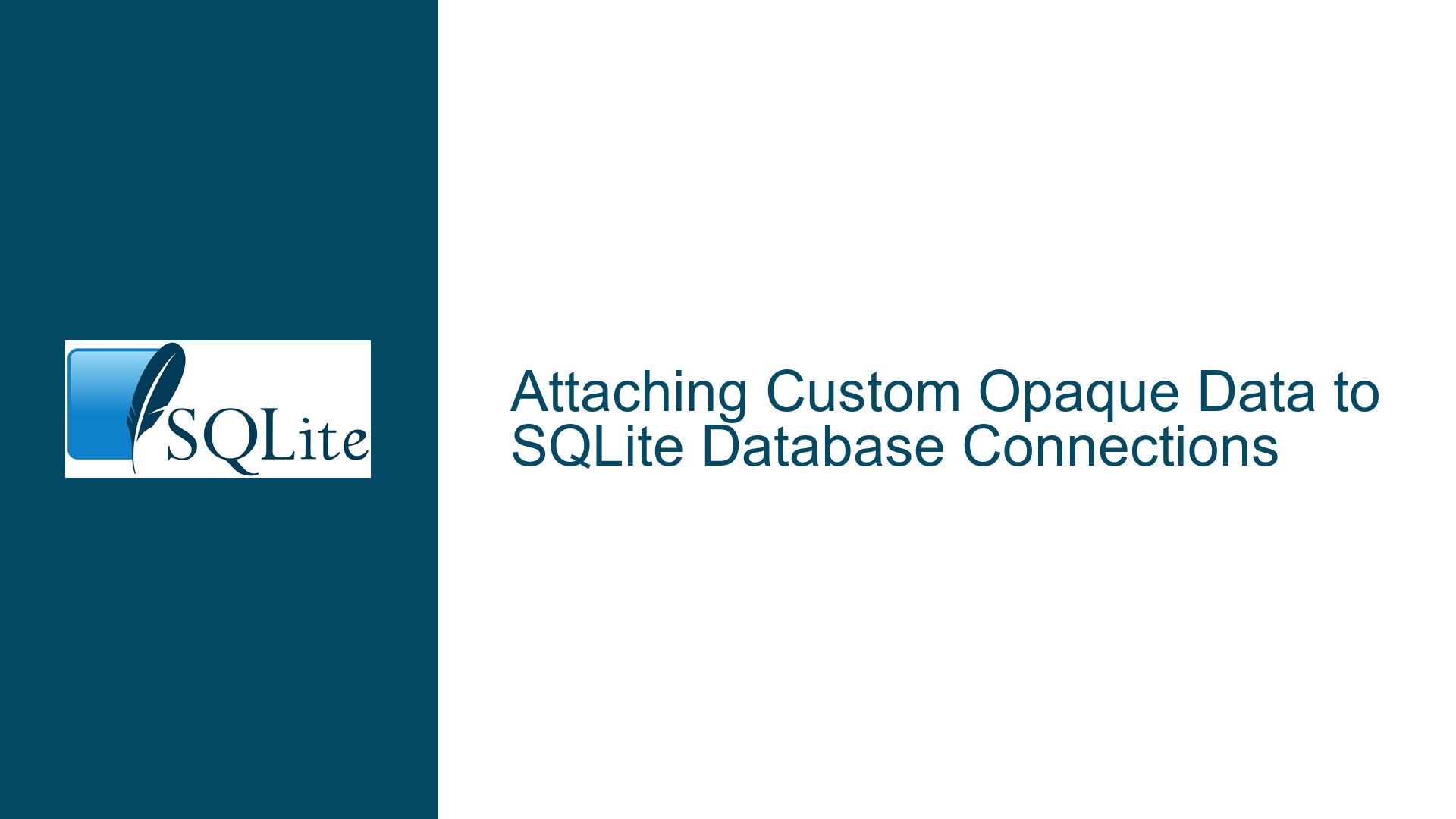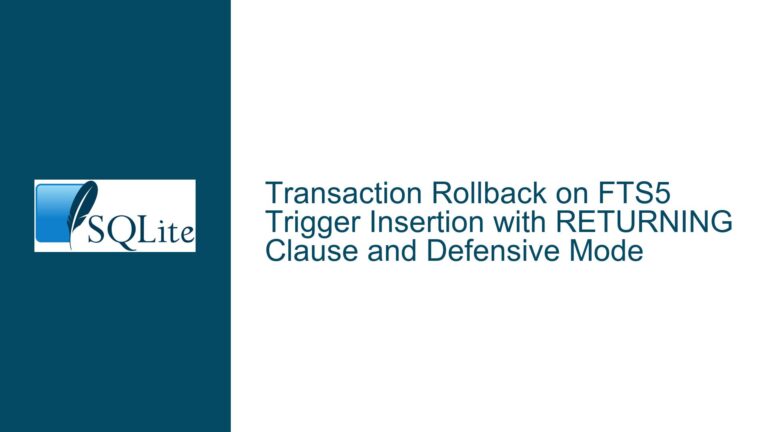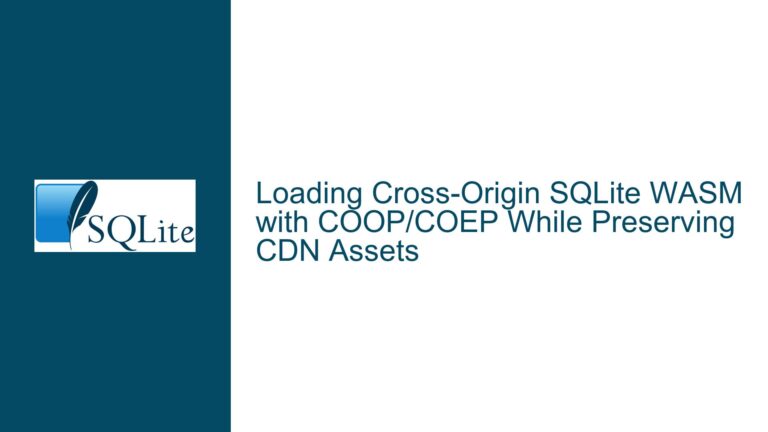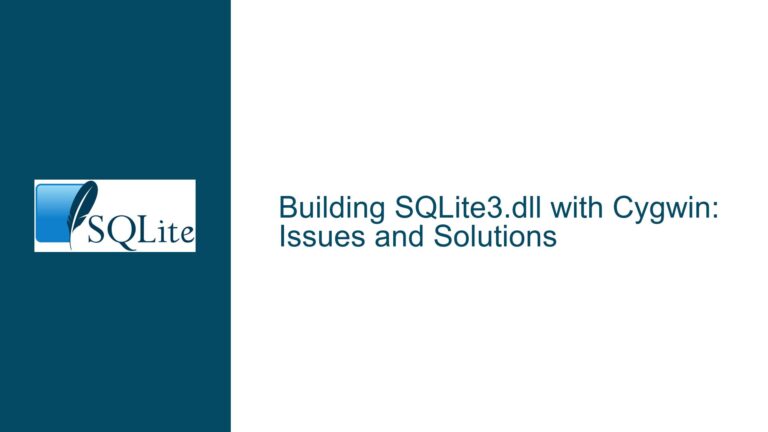Attaching Custom Opaque Data to SQLite Database Connections
Understanding the Need for Connection-Specific Opaque Data
In SQLite, developers often encounter scenarios where they need to associate custom application-specific data with a database connection. This data, typically represented as a void* pointer in C/C++, might include context handles, configuration objects, or runtime state that must persist across multiple database operations. The challenge arises because SQLite does not provide a direct, built-in API to attach arbitrary opaque data to a sqlite3* connection handle.
This limitation becomes apparent when extending SQLite with custom functions, virtual tables, or other extensions that require connection-specific context. For example, a developer might want to store a reference to a memory cache, a network connection pool, or a thread synchronization object tied to a specific database session. Without a mechanism to bind such data directly to the connection, developers must resort to workarounds or indirect methods, which introduce complexity and potential for error.
The confusion surrounding this issue often stems from SQLite’s existing APIs that seem related but serve different purposes. For instance, the sqlite3_get_auxdata and sqlite3_set_auxdata functions manage auxiliary data tied to specific function invocations within a connection, not the connection itself. Similarly, the pointer-passing interfaces (sqlite3_bind_pointer, sqlite3_result_pointer) allow pointers to be exchanged between SQL and C code but lack a built-in mechanism for permanent association with a connection.
Why SQLite Lacks a Direct Opaque Data Attachment Mechanism
The absence of a native API for attaching opaque data to a database connection is rooted in SQLite’s design philosophy and historical evolution. SQLite prioritizes minimalism, portability, and simplicity, avoiding features that could complicate its core functionality or increase its footprint. However, three key factors contribute to this specific limitation:
Architectural Boundaries:
SQLite’s C API is designed to abstract low-level database operations without assuming how higher-level applications manage state. Allowing arbitrary data to be attached to connections would require SQLite to manage memory ownership, lifetime, and thread safety for such data—responsibilities that conflict with its lightweight design.Ambiguity in Data Lifetime Management:
Attaching avoid*pointer to a connection raises questions about when and how the data should be released. Should SQLite automatically free the data when the connection closes? What if the data is shared across multiple connections? Resolving these questions would necessitate additional API parameters (e.g., destructor callbacks), complicating the interface.Overlap with Existing Mechanisms:
SQLite provides alternative methods to achieve similar outcomes, albeit indirectly. For example, thesqlite3_create_module_v2function allows a module destructor to be specified when registering a virtual table, enabling module-specific cleanup. Similarly, user-defined functions can leveragesqlite3_user_datato access a pointer provided during function registration. These mechanisms, however, are context-specific and not universally applicable to arbitrary connection-associated data.Historical Precedent:
Until recently, the demand for a generic connection-specific data API was not sufficiently widespread to justify its inclusion in SQLite’s core. Most use cases were addressed through existing workarounds, such as binding pointers via SQL functions or leveraging the Virtual File System (VFS) shim layer. However, as SQLite’s role has expanded into more complex embedded systems, the need for a direct solution has grown.
Strategies for Binding Custom Data to SQLite Connections
While SQLite lacks a built-in API for attaching opaque data to connections, developers can employ several strategies to achieve similar results. Each approach has trade-offs in complexity, portability, and maintainability.
1. Pointer-Passing Interfaces with SQL Functions
The pointer-passing interfaces (sqlite3_bind_pointer, sqlite3_result_pointer) allow pointers to be exchanged between SQL statements and C code. By defining a custom SQL function, developers can store and retrieve a pointer associated with a connection.
Implementation Steps:
Define a Custom SQL Function:
Create a scalar SQL function (e.g.,connection_pointer()) that uses thesqlite3_result_pointerAPI to return a pointer. Usesqlite3_bind_pointerto bind the pointer to a prepared statement.void get_pointer(sqlite3_context *ctx, int argc, sqlite3_value **argv) { void *p = sqlite3_user_data(ctx); sqlite3_result_pointer(ctx, p, "MyDataType", NULL); }Associate the Pointer with the Connection:
During database connection initialization, register the SQL function and pass the pointer as user data.sqlite3 *db; sqlite3_open(":memory:", &db); void *my_data = malloc(1024); sqlite3_create_function(db, "get_pointer", 0, SQLITE_UTF8, my_data, &get_pointer, NULL, NULL);Retrieve the Pointer in Application Code:
Execute a SQL query that invokes the custom function and extract the pointer usingsqlite3_value_pointer.sqlite3_stmt *stmt; sqlite3_prepare_v2(db, "SELECT get_pointer()", -1, &stmt, NULL); sqlite3_step(stmt); void *p = sqlite3_value_pointer(sqlite3_column_value(stmt, 0), "MyDataType");
Advantages:
- Minimal overhead; leverages existing SQLite APIs.
- Pointers are type-checked using a string identifier (e.g., "MyDataType").
Limitations:
- Requires executing SQL queries to store/retrieve pointers.
- The pointer is tied to the SQL function’s user data, which is static after registration.
2. Virtual File System (VFS) Shim Layer
SQLite allows custom VFS implementations to intercept file operations. By creating a VFS shim, developers can attach arbitrary data to the VFS object associated with a connection.
Implementation Steps:
Create a VFS Shim:
Define a wrapper VFS that delegates operations to the default VFS but includes additional fields for custom data.typedef struct { sqlite3_vfs base; void *custom_data; } CustomVFS;Initialize the VFS Shim:
Register the custom VFS during application startup and configure it to wrap the default VFS.CustomVFS *pVfs = malloc(sizeof(CustomVFS)); sqlite3_vfs *default_vfs = sqlite3_vfs_find(NULL); memcpy(pVfs, default_vfs, sizeof(CustomVFS)); pVfs->szOsFile += sizeof(void*); // Reserve space for custom data sqlite3_vfs_register((sqlite3_vfs*)pVfs, 0);Attach Data to the Connection:
When opening a new database connection, SQLite creates an instance of the VFS. Store the custom data in this instance.sqlite3 *db; sqlite3_open_v2("file:test.db", &db, SQLITE_OPEN_READWRITE, "custom_vfs"); CustomVFS *pVfsInstance = (CustomVFS*)db->pVfs; pVfsInstance->custom_data = my_data;
Advantages:
- Data is directly associated with the connection via its VFS.
- No need to execute SQL queries to access the data.
Limitations:
- Requires deep understanding of SQLite’s VFS internals.
- Overhead of maintaining a custom VFS implementation.
3. Pending Native API (Under Development)
As of August 2023, a new API for attaching opaque data to connections is under active discussion and development. This API, tentatively named sqlite3_set_connection_pointer and sqlite3_get_connection_pointer, will allow developers to bind and retrieve a void* pointer directly to a sqlite3* handle.
Anticipated Usage:
// Set the pointer
sqlite3_set_connection_pointer(db, pData, destructor);
// Get the pointer
void *pData = sqlite3_get_connection_pointer(db);
Advantages:
- Eliminates the need for workarounds.
- Native support for data lifetime management via destructor callbacks.
Limitations:
- Not yet available in stable SQLite releases.
- Requires upgrading SQLite once the feature is finalized.
Recommendations:
- For immediate needs, use the pointer-passing interface if the data is only accessed via SQL functions.
- For complex scenarios requiring low-level access, implement a VFS shim.
- Monitor SQLite’s release notes for the upcoming native API and plan migrations accordingly.
By understanding these strategies, developers can effectively associate custom data with SQLite connections while balancing trade-offs in complexity and maintainability.






